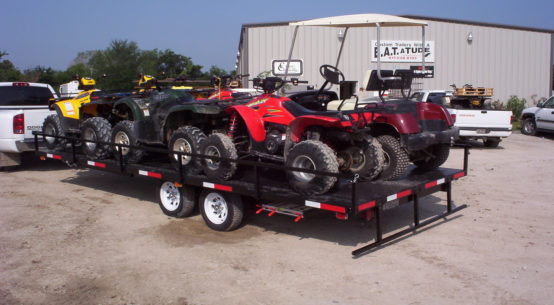
The greatest invention for ATVers, since the padded seat, is without a doubt the Helmet Comm. This device permits ATV to ATV communication without a great deal of hassle. My first opportunity to use the Helmet Comm was enough to sell me on the idea. For several years I have been using two way radios, but found that the light duty ear pieces were impossible to keep in my ear while riding and were also impossible to keep in my helmet. More times than not, I couldn’t find the little PTT (Push To Talk) button on the cable when the ear bud was in my ear.
The Helmet Comm solves all those problems and more. The Helmet Comm is designed with a boom mike that locates literally immediately in front of your mouth. The PTT button is on the side of your helmet and large enough that you can even find it with your gloves on. There is an optional PTT extension button that you can place on your handlebar if you would like. This would keep your hands in control while riding at all times. There is a set of speakers that are placed inside the ear well of your helmet and you can Velcro in place the wires and hide them neatly beneath the edges of the padding on the helmet. An antenna sits atop the control box for the unit so that you have a higher point of transmission thus improving your transmission radius. The control unit uses both a clamp and a Velcro solution to affix to your helmet and once applied will be very challenging to shake off while riding. The unit will fit on any presently known helmet unit.
The manufacturer, Precision Electronics, of Centerville, Utah, reports that thousands of these units have been sold to Snowmobilers. ATVers have been slow to catch on but once they do, they are permanently hooked. On a ride I recently took with the Helmet Comm attached to my helmet, one of the members of our party became wedged in a crevasse that had eroded into the trail. Although I, as the lead rider, was about a half a mile ahead, there was no problem contacting me and getting me to return to the scene of the difficulty. This was in thick tree terrain.
Our purpose on this ride was to search for a missing person, so the fact that we all had radios made it very easy to stay together and manage the specifics of the search without having to stop and pass the message voice to ear. The messages still passed voice to ear, but via the helmet comm.
This device makes all the difference in the world in making the ride enjoyable and permitting a sense of togetherness in an otherwise solo sport. (Husbands and wives should wear these things all day long, don’t you think?) The cost of this accessory is pretty reasonable. At only $99.00 for each Helmet Comm they are an affordable accessory for all the ATVers in the home.
There are a variety of radios that can attach to the Helmet Comm. They are specifically designed for the 5 Watt VHF, UHV radios. However, they will also work quite nicely with FRS and GMRS radios. The extension antenna may not be possible for FRS radios, since there are few that have removable antennas. The FRS and GMRS radios will require an adjustment to the microphone so that they will be able to pick up the lower powered microphone noise.
We used the GMRS radios and found that they work quite well up to a half mile even in dense forest terrain. In open terrain we found reception quite good up to a mile and a half. It may have good reception at greater distances, but we’ve never tested that.




